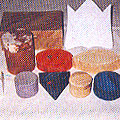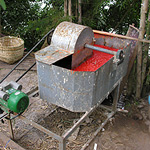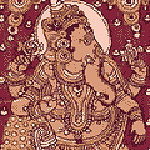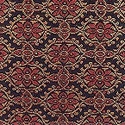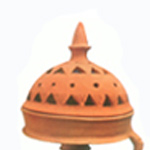India's paper tradition has an antiquity of nearly a thousand years. Even though is presently caught in a struggle between the changing past and an unknown future, India still has the largest population of hand paper makers in the world
India's paper tradition has an antiquity of nearly a thousand years. Even though is presently caught in a struggle between the changing past and an unknown future, India still has the largest population of hand paper makers in the world.
India's paper tradition has an antiquity of nearly a thousand years. Even though is presently caught in a struggle between the changing past and an unknown future, India still has the largest population of hand paper makers in the world.
The craft of making handmade paper has its origins in the Kagzi community that specialized in the making of paper. This community accompanied Mughal emperor Babur to India and settled in Sanganer on the invitation of Maharaja Jai Singh. It is extremely eco-friendly as it is acid free and consumes less energy and water in comparison to machine made paper. Production cluster centers around Sanganer. Tools such as sieve, scissors and vats are used for the process of making this paper.
India's paper tradition has an antiquity of nearly a thousand years. Even though is presently caught in a struggle between the changing past and an unknown future, India still has the largest population of hand paper makers in the world.
Handmade paper is used multi-fold in Sikkim, from religious manuscripts to its use in monasteries by monks to being sold to the government. The handmade paper is further treated with local herbs enabling preservation for several decades, a common practice for religious manuscripts in Sikkim. Other uses include utilitarian products such as file covers, bags, photo frames, lamps, to name a few. In the older days however, handmade paper was extensively used as is to maintain official records, notifications of the Chogyal's durbar and the state gazettes.
The basic raw material for the handmade paper stems from two sources - recycled paper and the lesser popular option now, locally available, Argali (Edgeworthia gardenia) bark. The making process first involves compiling and sorting the waste material - primarily old files and documents from the office and cloth waste - rags, synthetics etc. A pulp is formed as the waste is mixed with water and put into a beater followed by lifting, a process of converting the pulp into rectangular shapes. Water is then removed by hydraulic pressing and individual sheets are left to dry before passing them through a calendar. The final step involves finishing and smoothing the paper through a series of hard pressure rollers. The handmade paper is now ready to be cut into the desired size.
A hand paper unit was also set up by the Directorate of Handicrafts & Handloom, Gangtok in 1957 to further promote the eco-friendly process of converting city waste into handmade paper.
Ahemedabad has been a founding handmade paper centre since 1411. The 'kagadi' artisans were patronised by the Islamic rulers. The pper from Ahmedabad is famous for its toughness and whiteness. Earlier, the industry of handmade paper was limited to its utilisation in 'khatavahi' (account ledgers used by traders). The craft suffered a decline under the colonial era, with the use of papermaking machines. Now with the demand of handmade crafts from different sectors, handmade paper is being used in producing stationery, deeds, book binds and also as effective sustainable alternatives for products made by non-biodegradable materials.
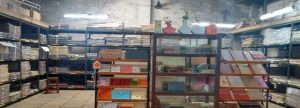
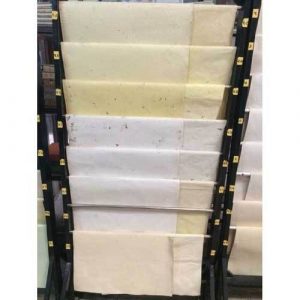
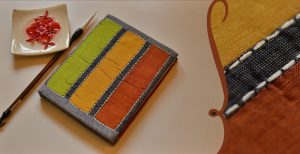
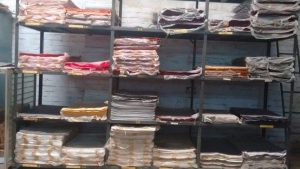
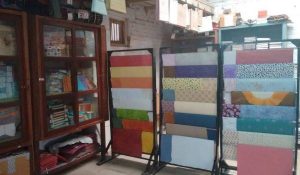
Before the introduction of paper, the leaves and bark of trees, the palm and plantain, especially the bhojpatr and talpatr were used. Cloth treated specially for use for manuscript, metal, leather including vellum, and parchment were also in use. Once introduced into this country, the craft of paper making flourished and demands for the country's handmade paper and handmade paper items have grown. Today a wide variety of materials are used to make paper: these include cotton rags, jute and hemp waste, old gunny bags and fishnets. Indigenous regenerating plants like flax, daphne, sun-hemp, sisal, water hyacinth, old paper, bamboo and bagasse are also popular. In each centre the material varies according to what grows in its surrounding environment or is easily and inexpensively available locally. Constant experimentation with new material is also adding to the list of already existing raw material. Recycling of old paper is another important source in the production of paper by hand. The technique of production today remains essentially the same as it was in the past. It has however been shortened and made less arduous by the introduction of some machines. The process of pulping is now carried out by electrically operated beaters rather than pounding by hand and the smoothening or 'calendering' of the paper is done by special hand operated machines. But the actual formation of the sheet is still entirely a handmade art. The drying paper, hung on clotheslines, adds a festive appearance to all production centres. The conversion of paper into products holds vast potential as items like gift boxes, visiting cards, toys, flower vases, flowers, greeting cards, writing pads, photo albums, ornament boxes, visiting cards, bags, pen holders and wrapping papers are being exported in large quantities. Locally, the paper is used to print wedding cards, view cards and invitation letters. New designs and varieties of paper are being experimented with constantly. The production of hand paper has, besides its inherent creative and aesthetic side, a strong economic and environment friendly basis. With the use of waste material, a low energy requirement, non-polluting technical process and no chemical additives it remains the product of choice.
Fine natural paper, made by hand, from the local saa or paper mulberry tree (broussonetia papyrifera), represents an unbroken tradition of papermaking, common across the South East Asian region, going back to over 700 years and possibly tracing its origin to the ancient art of papermaking in China. The paper mulberry tree is a small deciduous tree native to Asia, which grows easily in this region. It is the inner bark of this tree that is used for making paper, not the pith nor the wood. Traditionally, this paper has been used for religious and ceremonial purposes on account of its lustre and incredible strength.
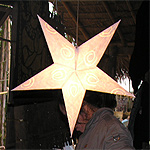
 |
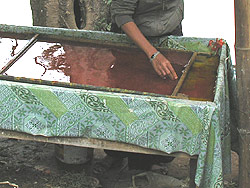 |
 |
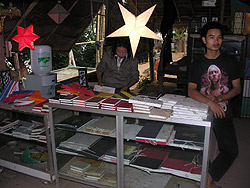 |
A small village near Daulatabad in Maharashtra is now losing its life because of the downfall of the craftwork that was once indigenous to place. Kagazipura which was once acknowledged as a settlement of skilled families and the art of making paper is now a village struggling to carry on its legacy with the support of a few power mills. Early Beginnings The name of the village is symbolic of the heritage it holds. It is trying to survive with its bygone history of the unique production of the handmade paper, an art which is almost 700 hundred years old and dates us back to the era of the Mughal reign. Studies show that India learned about paper production a millennia after China did. According to archaeological evidence, during the Mughal invasions, there was an influx of knowledge and new industries along with the Islam propaganda. Where there were several hubs which were mushrooming throughout India after the introduction of this new technology, there was an uprise in papermaking as an industry and means of livelihood under the reign of Sultan Muhammad bin Tughlaq. The credit of the existence of the papermaking industry in Maharashtra in Aurangabad and Daulatabad district is given to Mohammad bin Tughlaq. After shifting his empire from the north side of the peninsula to Daulatabad, the focus of his empire’s development was centralized to Daulatabad and its residents. Demand for the paper came from all over and was particularly high in the southern region. People who indulged in papermaking were called Kagzis. Since it was a family business there were huge migrations to pivot towards the activity center. People shifted their belongings and made settlements- weavers, artisans, paper makers, people belonging to various levels of social strata. Many kagzi families had to shift their bases from other parts of the region to Daulatabad plateau. The geography of the place allowed the paper industry to flourish. There was an abundance of water and space required to making handmade paper which was provided by the nearby lakes. Kagzi families shifted and settled near the lakes and started producing paper from their homes. This settlement was hence referred to as the Kagazipura village. It was from here the courts would retrieve paper and communicate within and outside their empire. Production In the 1930s then ruler, Nizam Asaf Jah VII formed a cooperative society called Handmade Paper Manufacturers Co op Industrial Society Ltd. It included all the families involved in the paper manufacturing unit in Kagazipura after independence by virtue of their service from the past. The process of handmade paper production used raw material such as hemp fibres, jute fibres, cloth rags, waste papers, barks from plants such as ramreetha. The raw material was boiled together and beaten with hammer into pulp to the consistency of cream with addition of water in a tank. Finely woven sieve was dipped into the creamy pulp. The sieve was taken out of the tank and the excess water was drained away from the sieve. The mixture was then pressed to rem,ove the remining water. Afyer dying, the sheet of paper was passed under a roller to obtain a smooth surface. hereafter Today the processs of making is by and large the same the only inclusion is of the machinery. The shredders, chindis or canvas rags and vegetable fibers are soaked in water overnight.This soaked mixture is then processed in the beater with a capacity of about 400 liters where it is stirred continuously till it settled down. A wooden rectangular frame overlaid by a bamboo/cane mesh is dipped horizontally into the Hauz and then lifted gradually upwards until the surface is reached. It is kept for a while for the excess water to drain off. The gathered layer of the thin pulp is covered with the terrycloth sheets and these sheets are then transferred on the wooden ply to completely get rid of the water content. Then each paper sheet is manually separated and they are hung for drying for a day after which, the paper is polished with a machine. A worker can produce 300-400 sheets a day. Kinds of Handmade Paper The paper from Daulatabad was unique and became famous for its glossiness and durability. There were numerous varieties in which it was produced such as: Nizam Shahi: Superior Quality Made using pieces of old ganni and tat superior quality Mohredar: made both in superior and inferior quality Shashista Khani: inferior quality made from rejected rags and old paper Bahadur Khani: Medium Quality, Thick Paper Sahib Khani: Medium Quality Thick Murad Shahi Paper: Fine Quality Sharbati: Thick and Fine Paper Today’s Scenario With today’s rapidly changing scenario and mechanical development, the craft of handmade paper is fading away. The total number of 10 mills was reduced to the only one which was relocated around 50 -60 years ago. The mill still carries its tradition of manufacturing paper both in a traditional and contemporary way. The repair of the mill is still an issue for local people and labor from which the livelihood depended. The major occupation of this paper village has changed to brick manufacturing and other professions so there is a decline in the paper production business. Water resources have depleted, it has become semi-arid and arid region. Usage of machinery has made the workers highly dependent on electricity, which directly affects the manufacturing process.
Harital an unusual paper has been in use in Nepal for many hundreds of years. The paper gets its name from harital (arsenic sulphide), a yellow mineral ore that is one of the ingredients that goes into the making of this paper. This archival and manuscript paper has been used for inscribing religious texts and manuscripts, and ancient scriptures, for casting horoscopes, as a base for paintings, and for the writing of documents of import like land records. The base of this paper is the indigenous Daphne (lokta) paper that undergoes complex treatment in the hands of knowledgeable specialists before its conversion into harital paper, which has a thick and weighty texture and a golden hue. On studying old manuscripts and records written on harital paper in museums and in private collections it is apparent that in spite of its antiquity the paper retains its colour and strength. It is necessary to use special inks on this paper - the most suitable are the locally produced black, gold, and silver inks. Harital paper is also highly valued as it is immune to moths and insects which, along with climatic factors, are the greatest enemy of paper.
The original inhabitants of Darjeeling are the Lepchas, with people from neighbouring Nepal, Bhutan, Sikkim, and Tibet, as well as from the plains of West Bengal and Bihar also there. The forested foothills are peopled by the semi-tribal rajbanshis and ravas of the north Bengal plains, mundari cultivators from the Chota Nagpur hills, and modesias who are descendants of the mixed tea-garden labour. The tea-garden workers are a mix of tribals from Chota Nagpur and Central India, people of surrounding hill regions, mainly Nepalis, and people from the plains of Bengal and Bihar. Bamboo, cane, and forest creepers are used efficiently by the hill inhabitants of West Bengal to make deep and shallow baskets of different kinds for domestic uses, beautifully shaped and intricately woven dowry boxes, and a large variety of fishing traps and cages for birds and animals. Bamboo is also used to make ceremonial vases for which bamboo with a wide diameter --- chhaya bans --- is used. Date and other palm leaves and grasses are used to weave mats. Another fine example of hill crafts is the intricately crafted mask made of khankpa wood which is used for ritual dances In the Chota Nagpur area, specially designed fabrics and agricultural and household implements made of iron and steel are made by weavers and blacksmiths respectively. Silver smiths and coppers miths who make exquisitely designed ornaments for tribal women also live among the tribals. Non-tribal craftspeople of Midnapore and Bankura districts also make the bell-metal and brass utensils used by the hill tribals. The handicrafts of Darjeeling are quite distinct from the crafts prevailing in the rest of West Bengal and express the cultural heritage of Buddhism prevailing in the eastern Himalayas. Bhutia basti or the Bhutia settlement or village has been built over the last 150 years, and is the home of craftspersons, painters, musicians, and traditional scholars who represent the whole of the folk cultures of the hill people of the eastern Himalayas. Hill craftspersons know and practise a number of crafts at the same time. The traditional hill craftsmen make the sculptural model for a bronze figure directly with wax for each individual bronze figure. The modelling of the figure is hollow, made of sheets of pliable wax, where the thickness of the sheets is determined by the desired thickness of the hollow bronze figure. A soft core mixture is poured inside to solidify and dry. The wax model is finished in detail before covering it with moulding materials of layers of clay mixtures of different compositions. Once this is dry the figure is cast. The wax layer melts leaving behind the perfectly chiselled metal figure. At Bhutia basti, both chemical dye stuffs as well as indigenously prepared vegetable dyes are used to colour the cloth. Traditional paintings by painters of the Bhutia basti depict themes from the Buddhist Jataka stories as well as from Buddhist scriptures. These are made in a scroll on handmade paper from Tibet and Nepal and mounted on cloth. The paintings are called thankas and are in the tempera technique, using finely ground stone and earth colours. Lapis lazuli, a blue stone colour, is obtained by grinding semi-precious stones from Tibet. The thanka is bordered with fine brocade having Buddhist motifs, especially made for this purpose at Varanasi. Thanka painters sometimes use gold leaf or powder to embellish their paintings. The process of applying gold on a thanka is very expensive and is a closely guarded secret. The painted scrolls are used in household shrines in all Buddhist homes among Nepali, Sikkimi, Bhutia, and Tibetan people, as well as in monasteries. Kalimpong in the Darjeeling district --- where a number of Nepali and Bhutia craftspersons live --- is on the trade route between India and Nepal. The crafts here were originally for colonial rulers, an example being embroidered knee-boots; these crafts are becoming very rare now. Bhutia artisans make beautifully shaped metal containers set with semi-precious stones. Kalimpong is also a centre for Tibetan carpets. Wool is spun by the Tibetan women of Darjeeling on a traditional spinning wheel called the chassba; they spin the wool continuously chanting the mantra, Om mani padme hum. The carpets woven by the Bhutia weavers have geometrical motifs, using blocks of colour to build them up. The loom has two vertical wooden beams with fixed pegs at the top and bottom, while two horizontal beams carry the warp threads of cotton tied to each other. The knotting is done by looping the thread around the warp and the rod which is used for looping is placed horizontally and at right angles to the warp. When a motif or other colours have to be introduced, the ground colour is cut and a new thread is inserted by twisting into a single warp thread and looping. A three ply twisted wool is thrown across to be used as a weft. The weaving is mainly done by women. The most common type of carpet is the small bedside carpet known as duns which has 60 knots to a square inch. Squares to sit on are called as asans. The motifs used are alpana designs, which are usually drawn on floors for festive occasions, geometrical patterns, floral designs, and some Tibetan symbols like the mythical birds called dak, jira the dragon, the lion, and the god of lightning, represented by a zig-zag line. Central Asian influence is seen in the key and swastika designs. The latter is curled instead of angular. Initially the weaving was done mainly in cotton but now woollen carpets are being woven. The Tibetan Refugees' Self Help Centre is mainly involved in this craft; the carpets made are up to 40 knots per square inch. Thematic interpretations of various elements in Tibetan iconography are woven in. The colour of the background is restrained but the design are in bold colours. The motifs include the dak goh or staring dragon, the pema gyaja which is a lotus and bird combination, or the pema thang tsi gumpo which is a lotus and bat combination. Gyaja thang medok is a bird and flower design whereas nehtsho thang medok is a parrot and flower combination. Other motifs include flowers in the field, broken borders of flowers and swastikas alternating, and the ganachari or Wall of China. A 'V'-shaped cut is made along the edges of the design to give relief to the parts of the design and thus to delineate it from the background.
It is said that the hills of Mizoram are alive with the sound of music. This strong sense of music and song of the Mizos has manifested itself in locally made musical instruments. One of these instruments is the ting-tong, a one-string Mizo musical instrument, which is very popular and commonly played, while some others like the traditional mithun horns, gongs and drums are only occasionally used. Preferences are changing, the guitar, locally made, is now very popular with the younger generation. Other Mizos instruments like the benz bung and the rewchhem (a long pipe) are no longer being used and very few Mizos know how to play them. Traditional ornaments of Mizoram include the thihus, a necklace with big amber beads, the thifen, a necklace with smaller beads, and the darthi, a necklace of glass beads. On special festive occasions Mizo women use a head gear called the vakiria. It consists of a bamboo band bedecked with a feather and decorated at the ends with beetle wings.
Himroo, a traditional brocade, with a history extending back to Mughal times, is an extra-weft, figured fabric. A complex weave, decorated with figurative motifs it was originally woven in running lengths to be made-up into Shervanis - the traditional dress of the Mughal courts. Now woven into shawls and other unstitched garments, Himroo is a craft that is languishing. This special cotton brocade is woven on a throw-shuttle loom and has a complicated technique of weaving. The design, planned by the Naksh bandh is usually geometric and floral, with birds and animals patterns woven in too. Intricate creeper designs are popular.
Himroo, a traditional brocade, with a history extending back to Mughal times, is an extra-weft, figured fabric. A complex weave, decorated with figurative motifs it was originally woven in running lengths to be made-up into Shervanis - the traditional dress of the Mughal courts. Now woven into shawls and other unstitched garments, Himroo is a craft that is languishing. This special cotton brocade is woven on a throw-shuttle loom and has a complicated technique of weaving. The design, planned by the Naksh bandh is usually geometric and floral, with birds and animals patterns woven in too. Intricate creeper designs are popular.
Pottery is as ancient as the civilization on Earth. Pottery in Assam is associated with two communities namely Kumhars/Kumar's and Hiras. Hira's are probably the oldest of the potters and one of a kind as they do not use potter's wheel for production. Pottery in Hira community is the work of women folk while the trading and sourcing of material is handled by men. The common earthen products are vessels, pots, pitchers, plates and other modern day items.
Hmaram is an elaborately decorated traditional fabric originating from Mizoram. It is a handmade shawl and an essential part of every Mizo woman’s wardrobe. It is worn like a short skirt and is draped around the waist. Hmaram is also the oldest patterned textile of the Lusei tribe, who have a special attachment to the shawl because of its legacy of customary designs and patterns. The artists weave beautiful motifs, often inspired by nature and the local surroundings. Mizo craftspeople are greatly aware and influenced by the flora around them and try to replicate them on their textiles. Unlike many other Mizo textiles, this cloth is of single-loom width. It is woven on a loin loom or handloom, using handspun indigo-dyed and natural white cotton. The industry and manufacturing units of Hmaram are mainly located in Aizwal, capital of Mizoram. It is most commonly worn during festive dances and official ceremonies.
In rural Haryana, it is a common sight to find men squatting below a tree and enjoying a smoking pipe. The hookah uses tobacco in its chilm/bowl and the burning coal helps to pass the essence of tobacco with smoke into the pipe that is held at the mouth.



